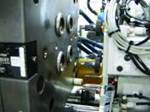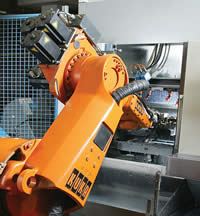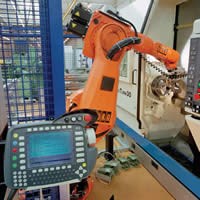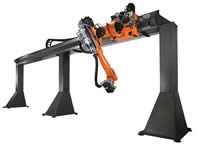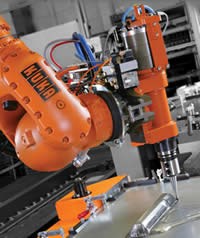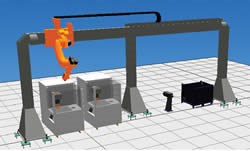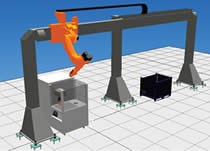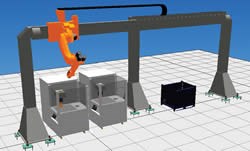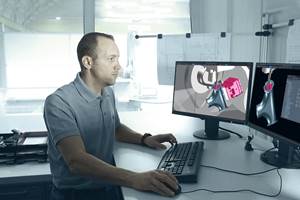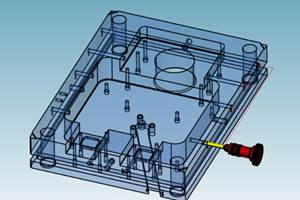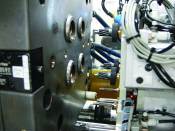Can Moldmakers Use Robotics Automation?
The pressures in today’s economic climate leave many companies struggling to find ways to contain manufacturing costs. One overlooked strategy applies to robotics automation.
The era of robotic automation’s reputation as an expensive, over complicated technology is gone. In recent years many small to medium-sized companies have turned to automation in order to compete with low-cost sourcing. Coupled with the significant cost reduction in recent years, many companies are able to justify return on investment in one to two years. As robotic automation becomes a mainstream solution, the technology becomes easier, with platforms such as PC-based controllers.
Think Strategically Before You Start
Adopting robotics can be very successful with the right approach and strategy. Begin your strategy by reviewing all the production activities your business accomplishes and develop a list of areas that could benefit with the efficient use of robotics. Common areas moldmakers apply robotics include: machine tending, part transfer, deburring, polishing, welding, spray arc hard-facing, or inventory handling.
Robotic Applications
Robotics in machine tending can cut costs dramatically by allowing skilled labor to focus on imperative production tasks. In automated machine tending the robot loads and unloads parts from the CNC machine. Using standard part holding fixtures simplifies the production setup as the robot always handles the fixture instead of the actual part. Minimal setup or modification to the control system may be required for robot and machine center communication for start of cycle, end of cycle and to decipher which CNC program to run for each part.
Deburring and polishing is an additional area where robotics has excelled in recent years. New force feedback capabilities help robots perform these operations more accurately. Robots have CAM capabilities that can read CNC G-code programs. The same NC CAM software used to program milling machines can be used to create complex polishing programs for the robots.
Return on Investment
When justifying return on investment, complete an accurate estimate of the potential cost savings for automating an area. Important factors to consider are labor cost, overtime, benefits, savings from reduced rework and scrap, and increased production rate. Robots work 24 hours a day, 7 days a week in dangerous and undesirable areas for employees or in lights-out facilities. Start with the area that offers the best savings. Robotics can be a phase added approach into your facility (see Phase illustrations). The cost savings from the first phase can be used to free manpower and capital to implement the next phase. Creating a master plan in the beginning helps the project stay on target and reduces risk.
Adding Modular Post Process Stations as Production Requires
When planning for future automation phases choose the best solution based on the space available for your application. The extremely large work area of some gantry robots—with a linear unit and jointed-arm robot combination—gives the automation cell maximum flexibility. Utilizing such a robot enables an end user to automate multiple machine centers, while using minimal floor space. Allow-ing the robot to manufacture the same part, several different parts or work together on a two-step process. Parts can be introduced into the system on easy-loaded pallets. As an option or additional phase, a second arm can be added to the rail to increase throughput and flexibility
PC-Based Control
Advantages to PC-based control technology are the ability to have the familiar Windows interface and Graphical User Interface software. Standard HMI (human machine interface) products are available to help designers create custom user interfaces for the robot. The HMI can pull status displays or control functions all together on one display at the robot. The interfaces can include text and graphics to describe the process and can even animate displays. Creating a simple and easy-to-use display helps reduce operator training and create a confident, efficient operator.
Training
When introducing new technology, personnel issues must not be overlooked. It is important that employees are educated on the use of robotics and trained properly to allow them to be more productive and available for effective projects. Proper training of operators is as critical as the design of the automation system. If employees feel threatened or untrained during the development stage of new equipment, it is less likely to succeed.
Summary
Robotic automation offers many direct benefits to the bottom line of your manufacturing operation. Many intangible benefits also exist; quality and consistency of the manufactured product will improve, embracing leading-edge technology improves corporate image and can help you understand the needs of your customers using robotics.
The playing field for manufacturing has changed. If you do not evolve and adapt the competition will. The benefits of robotics are proven. Can you afford to avoid progress?
Related Content
How to Automate Process and Design
Moldmakers can improve their operations and stop wasting time by taking these six steps for process and design automation.
Read MoreAchieving Flexible Capacity with Automation
This high-mix, low-volume manufacturer embarked on a year and a half program to introduce robotics to its manufacturing process.
Read MoreCAM Automation Increases Mold Production, Quality
Mold builder switches CAM software package after 20 years to take advantage of innovative programming strategies that reduce mold machining programming and processing times.
Read More2024 Moldmaking Insights: A Year in Review Part 1
A look back at the top moldmaking trends of 2024, as revealed through MMT's analytics. This review highlights the most popular technical articles, case studies, tips and best practices that captured the industry's attention over the past year.
Read MoreRead Next
Mold Design Tips for Automation
Automation suppliers can assist mold manufacturers with proper mold design and engineering before cutting steel for new molds. Hot runner molds, cold runner molds, box filling, insert molding, stack molds and multi-component molding are areas that can be built and managed more inexpensively, reliably and simpler.
Read MoreAre You a Moldmaker Considering 3D Printing? Consider the 3D Printing Workshop at NPE2024
Presentations will cover 3D printing for mold tooling, material innovation, product development, bridge production and full-scale, high-volume additive manufacturing.
Read MoreHow to Use Continuing Education to Remain Competitive in Moldmaking
Continued training helps moldmakers make tooling decisions and properly use the latest cutting tool to efficiently machine high-quality molds.
Read More
